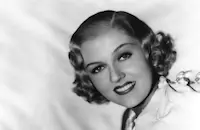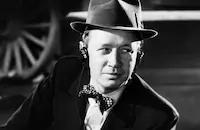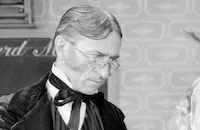Boulder Dam

Brief Synopsis
Cast & Crew
Frank Mcdonald
Ross Alexander
Patricia Ellis
Lyle Talbot
Eddie Acuff
Henry O'neill
Film Details
Technical Specs

Synopsis
Rusty Noonan, a wisecracking mechanic with a chip on his shoulder, inadvertently kills his boss at Detroit's United Taxi Co. during an argument. In a panic, he runs away, heading West. While walking through the desert, he stops to fix Ann Vangarick's car, and she offers him a lift in return. He has heard that there is plenty of construction work at Boulder Dam, but when he shows up several days in a row without getting hired, he leaves in a huff. He meets Ann again in the Las Vegas club where she is a singer. Over dinner, he tells Ann his name is Joe Callahan. Wanting to give him a break, she invites him home for the night, but when he makes a pass at her, she straightens him out right away. Her family, recent immigrants, are generous people. Slowly, Rusty accepts their good will, and one night when the men are talking about how much the dam means to them, Rusty decides to reapply for work there. Under Ann's influence, he rapidly makes good, and when he unloads a runaway dynamite truck, he is suddenly a hero. Shortly afterward, Agnew, the head of the project, promotes Rusty. Feeling accepted for the first time, Rusty asks Ann to marry him and she gladly agrees. As he celebrates his engagement with some of the men, Lacy, a former suitor of Ann, reveals that he knows Rusty's real identity and threatens to tell the police if Rusty doesn't leave town alone within twenty-four hours. Before he can make good on his threat, however, a carrier cable breaks, placing Lacy's life in danger. Selflessly, Rusty rescues him and realizes that he must tell the truth about himself. When he confesses to Agnew, he is told that he must return to Detroit to take his punishment, but that the company will stand by him as will Ann.

Director
Frank Mcdonald
Cast

Ross Alexander

Patricia Ellis

Lyle Talbot

Eddie Acuff

Henry O'neill
Egon Brecher
Eleanor Wesselhoeft

Joseph Crehan
George Breakston
William Pawley
Ronnie Cosby

Olin Howland
Crew
Sy Bartlett
Sam Bischoff
Ralph Block
Mort Dixon
Leo F. Forbstein
Leslie G. Hewitt
Frank Mattison
Hugh Reticker
Thomas Richards
Jack Saper
Dan M. Templin
Arthur L. Todd
Jack L. Warner
Allie Wrubel

Film Details
Technical Specs

Articles
Boulder Dam
The plot is a Warner's standby that served stars like James Cagney and Pat O'Brien well in the studio's A pictures -- a young hotshot first disgraces himself, then finds a new lease on life thanks to a manly, usually dangerous job and the love of a good woman. This time out, the hot shot is a disgruntled mechanic who accidentally kills the boss during a heated argument. Going on the lam to avoid prosecution, he ends up in Nevada, where he falls for blonde nightclub singer Patricia Ellis and lands a job helping to build Boulder Dam. When an act of courage brings him to public notice, Alexander manages to keep his picture out of the papers. Then, when he and Ellis announce their engagement, he comes up against a rejected suitor (Lyle Talbot) who knows his real name and why he's on the run.
Most of Warner's "torn from the headlines" films were gangster pictures, a genre that really didn't suit the tall, patrician Alexander. Fortunately, the studio also decided to cash in on the nearing completion of Boulder Dam (now Hoover Dam), which opened two-years ahead of schedule on March 1, 1936, just six day's before the film's premiere. Warner's even trumpeted the film's timeliness in their trailers: "America writes history again, and Warner Bros. brings it to you with all the drama, courage and suspense that went into the construction of Boulder Dam."
Of course, the film was hardly a documentary. Rather it used the historic event for low-budget thrills as Alexander ran down a runaway dynamite truck and fought to rescue the occupants of a damaged cable car. The Nevada setting even allowed them to throw in a musical number for Ellis ("Long Gone Baby" by Allie Wrubel and Mort Dixon). It all made for a compelling trailer and an effective bottom half of a double bill.
Still, it could not have been much of a thrill for Alexander to get his first shot at top billing in what was clearly a low-budget production. Ellis, whose career also lasted a mere seven years before she left the screen to marry a wealthy businessman, even used to refer to herself jokingly as "the Queen of B pictures at Warner Bros." She had replaced Alexander's original leading lady, Ann Dvorak, whose promising career had floundered after a series of low-budget films and high-profile arguments with her bosses at Warner Bros. Director Frank McDonald was hardly one of the studio's top helmers and would eventually end up directing low-budget Westerns at Republic Pictures.
Yet Boulder Dam certainly has its charms, particularly in Alexander's good looks and impressive performance. Nor was it unheard of for young actors to get their first shots at stardom in low-budget films. Alexander was actually lucky to get a second shot at stardom after his poor showing in his first leading role, in Maybe It's Love (1935), a tepid remake of Saturday's Children (1929), based on the hit Broadway comedy that had helped make Ruth Gordon a star. The young actor had been earning solid notices, however, for his supporting performances in bigger-budgeted films like the Dick Powell-Ruby Keeler vehicles Flirtation Walk (1934) and Shipmates Forever (1935). With the success of another supporting role in Captain Blood (1935), his career was on the upswing. In fact, Warner Bros. billed him in trailers for Boulder Dam as "The screen's fastest rising young star."
Unfortunately, a series of personal problems would slow that rise, eventually cutting his life short. Shortly before Boulder Dam's release his wife, actress Aleta Friele, had committed suicide. Whether the act was motivated by her own stalled career, a failing marriage and, as some gossips suggested, discovering that her husband was bisexual, will never be known. The scandal cost him a loan-out to Fox and may have started him on a cycle of depression. There was also a violent run-in with Bette Davis's husband after Alexander's attempts to court the married star and land a role opposite her reached a level that would be labeled "stalking" today. His behavior led Davis to approach studio management and demand they never be teamed. Alexander also had to call in Warner's publicity department for help when a tryst with a male hitchhiker led to blackmail, an incident not revealed for 50 years. On the surface, he gave signs of recovering, with a new marriage to co-star Anne Nagel and more promising roles at Warners, including the lead in Ruby Keeler's new film, Ready, Willing and Able (1937). Depression, complicated by heavy drinking, proved too much for him, however. After completing that picture, he committed suicide on January 2, 1937, cutting short the promising career of one of Hollywood's most fascinating and troubled young leading men.
Producer: Samuel Bischoff
Director: Frank McDonald
Screenplay: Sy Bartlett, Ralph Block
Based on a story by Dan M. Templin
Cinematography: Arthur L. Todd
Score: Heinz Roemheld
Cast: Ross Alexander (Rusty Noonan), Patricia Ellis (Ann Vangarick/Eve La Tour), Lyle Talbot (Mr. Harry Lacy), Eddie Acuff (Ed 'Alley Oop' Harper), Henry O'Neill (Mr. Agnew), Egon Brecher (Pa Vangarick), Joseph Crehan (Ross), Ward Bond (Pa's Guest).
BW-70m.
by Frank Miller

Boulder Dam
Quotes
Trivia
Notes
Dan M. Templin's story idea was entitled "Boulder Dam." The film's pre-release title was Backfire. Contemporary sources credit Tommy Richards as film editor, but Saper is credited on the film. According to Motion Picture Herald's "In the Cutting Room" column, Laird Doyle was assigned to write the screenplay, but his contribution to the final film is undetermined. News items in Daily Variety note that Patricia Ellis replaced Ann Dvorak as the lead, with the result that the dancing role planned for Dvorak was changed to a singing role. A news item in Lib mentions that Ray "Red" Russell, a former Boulder Dam worker, worked on the film. In 1947, Boulder Dam was renamed Hoover Dam in honor of former President Herbert Hoover, who authorized the dam's construction.















